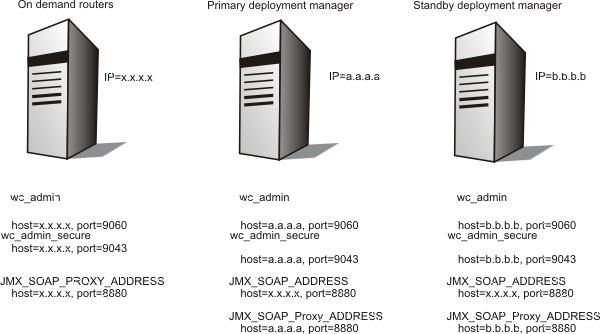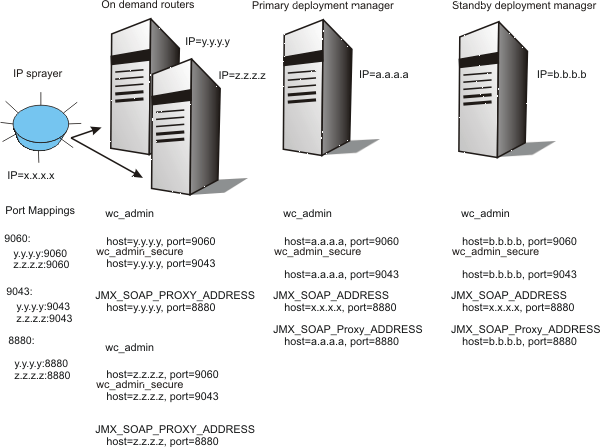xd_hadmgrAdd command
The xd_hadmgrAdd command incorporates a new deployment manager profile into a cell. The new deployment manager profile is converted to a highly available (HA) deployment manager peer in the same cell as the existing deployment manager profile. The command must be run within the new deployment manager profile that is being added.
Syntax
The command syntax follows:xd_hadmgrAdd -hostname (primary_dmgr_host) [-port (primary_dmgr_port)] -configRoot (fully_qualified_path_to_shared_configuration)] -workspaceRoot(fully_qualified_path_to_workspace) -proxyServerJmxSoapAddress (JMX_SOAP_host):(JMX_SOAP_host) -proxyServerHttpPort (HTTP_port)(HTTP_secure_port) [-uniquePort] [-user (uid)] [-password (pwd)] [-quiet] [-logfile (filename)] [-replacelog] [-trace] [-help]
The proxyServerJmxSoapAddress and proxyServerHttpPort parameters are required only when you are creating the first standby deployment manager.
Parameters
The following options are available for the xd_hadmgrAdd command:
- -hostname <host name>
- Specifies the host name used to connect to the existing deployment manager.
- -port <port>
- Specifies the port used to connect to the existing deployment manager.
- -configRoot <fully qualified path>
- Specifies the fully-qualified configuration path.
- -workspaceRoot <fully qualified path>
- Specifies the fully-qualified workspace path.
- -proxyServerJmxSoapAddress <host:port>
- Specifies the ava Management Extensions (JMX) SOAP address for the proxy server.
- -proxyServerHttpPort <port> <secure_port>
- Specifies the HTTP ports for the proxy server.
- -user <user>
- Specifies the user name that is used to connect to the existing deployment manager.
- -password <password>
- Specifies the password that is used to connect to the existing deployment manager.
- -quiet
- Suppresses the progress information that the xd_hadmgrAdd command prints in normal mode.
- -logfile <filename>
- Specifies the location of the log file to which information gets written. By default, the hadmgrAdd.log file is created in the logs directory of the profile for the node that is being added.
- -replacelog
- Replaces the log file instead of appending to the current log. By default, the xd_hadmgrAdd command appends to the existing trace file. This option causes the xd_hadmgrAdd command to overwrite the trace file.
- -trace
- Generates additional trace information in the log file for debugging purposes.
- -uniquePort
- Checks for port conflict. If the new port is conflict with the existing ports, the new port increments by one until a free port is found. This process is not necessary if unique ports were assigned to the deployment manager profile when it was created.
- -help
- Displays syntax help.
Usage
The following examples demonstrate correct syntax:
Starting with a pre-existing Network Deployment cell, installed and configured in the following directory structure:
| Description | Name |
| WebSphere Application Server home directory | /WebSphere/AppServer/ |
| Existing deployment manager profile | /shared/profiles/PrimaryManagerNode |
where the /shared mountpoint is on a SAN FS device.
Run the profile configuration tool or wasprofile command line utility to create another deployment manager profile associated with this same Network Deployment installation. Create this profile on the shared disk, /shared mountpoint for this example. You must specify the correct host name for this deployment manager to listen on. You can specify the explicit port numbers for your standby deployment manager when you create the profile or you can specify the -uniquePort parameter when you run the xd_hadmgrAdd command, as shown in this example. You can specify any value for the cell name, because it is changed to match the cell name to which this HA deployment manager peer is added during the conversion process. You must specify a node name that is unique in the cell to which this HA deployment manager peer is added. After creating the profile you have:
| Description | Name |
| WebSphere Application Server home directory | /WebSphere/AppServer/ |
| Existing deployment manager profile | /shared/profiles/PrimaryManagerNode |
| New deployment manager profile | /shared/profiles/StandbyManagerNode |
xd_hadmgrAdd.bat.sh –hostname a.a.a.a -port 8880 -configRoot /shared/profiles/PrimaryManagerNode/config -workspaceRoot /shared/profiles/PrimaryManagerNode -proxyServerJmxSoapAddress x.x.x.x:8880 -proxyServerHttpPort 9060 9043 -user wsadmin -password ******** -uniquePort
If you install the centralized installation manager repository, and after you create the second deployment manager profile, change the value of the CENTRALIZED_INSTALL_REPOSITORY_ROOT property in the install_root\properties\cimgr.props file from c:\ProgramFiles\IBM\WebSphere\AppServer\repository_folder to ${WAS_INSTALL_ROOT}/repository_folder.
Use the xd_hadmgrAdd command makes the following changes to your cell configuration:
- The new deployment manager is configured to use the same configuration repository instance as the existing deployment manager, which must be on a shared device with the existing deployment manager.
- The new deployment manager is configured to use the same specified workspace shared directory, which must be on a device shared with the existing deployment manager.
- The on demand router (ODR) is configured with the following:
- wc_admin and ws_admin_secure HTTP transport channels.
- JMX_SOAP_PROXY_ADDRESS endpoint.
- The deployment managers are re-configured as follows:
- Their JMX_SOAP_CONNECTOR addresses point to the JMX_SOAP_PROXY_ADDRESS of the ODR.
- They have a JMX_SOAP_PROXY_ADDRESS added that holds the same configured host or port as their original JMX_SOAP_ADDRESS.
Use the xd_hadmgrAdd command makes the following changes to your cell configuration:
As a result of the configuration change, the ODR hosts the logical endpoints for the deployment manager and proxies communication requests for the deployment manager to the active deployment manager.
For example in a non-HA ODR configuration, the deployment manager configured host name points to the ODR:

To eliminate the ODR as a single point of failure, a HA ODR configuration is recommended with at least two ODRs receiving traffic from an internet protocol spraying device. In this case, the deployment managers JMX_SOAP_ADDRESS configured host name points to the device:

The HA deployment manager function only supports use of the JMX SOAP connector. The JMX RMI connector is not supported in this configuration.
- The new deployment manager is configured to use the same configuration repository instance as the existing deployment manager, which must be on a shared device with the existing deployment manager.
- The new deployment manager is configured to use the same specified workspace shared directory, which must be on a device shared with the existing deployment manager.
- The on demand router (ODR) is configured with the following:
- wc_admin and ws_admin_secure HTTP transport channels.
- JMX_SOAP_PROXY_ADDRESS endpoint.
- The deployment managers are re-configured as follows:
- Their JMX_SOAP_CONNECTOR addresses point to the JMX_SOAP_PROXY_ADDRESS of the ODR.
- They have a JMX_SOAP_PROXY_ADDRESS added that holds the same configured host or port as their original JMX_SOAP_ADDRESS.
Related concepts
The high availability deployment manager
Related tasks
Configure a high availability deployment manager environment
Installing WebSphere XD
Related information
xd_hadmgrRemove command